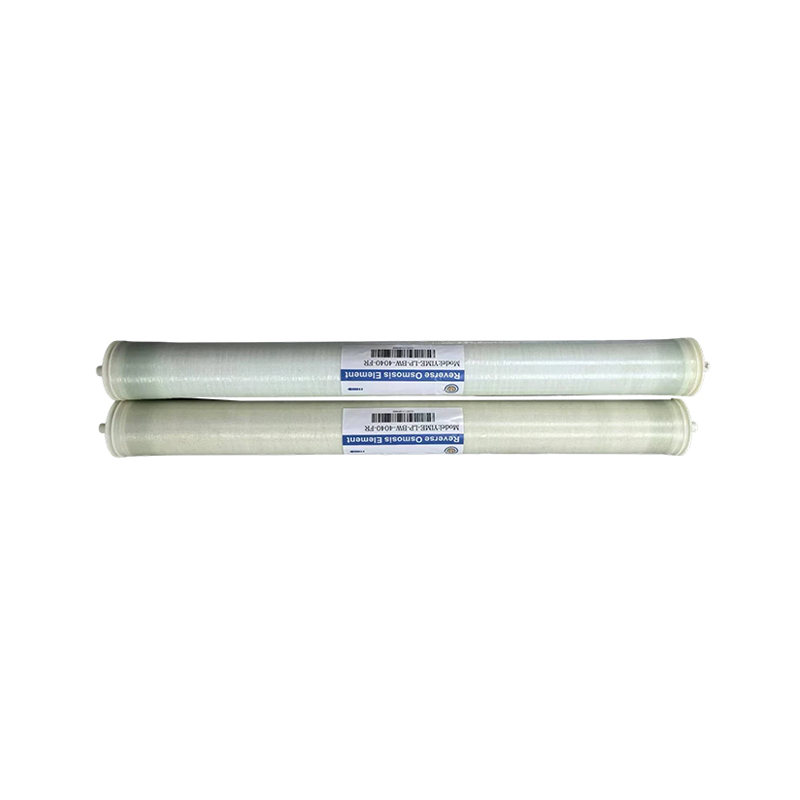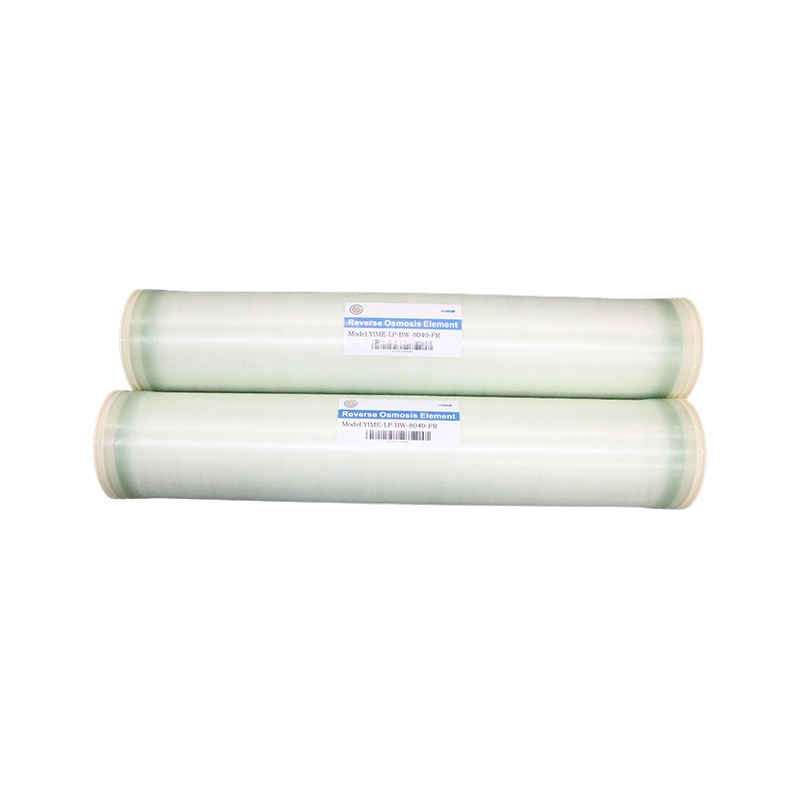How does reverse osmosis (RO) membrane efficiently remove viruses from water?
Release Time : 2025-03-17
In today's society, with the acceleration of industrialization and the continuous growth of population, the safety of water resources has become increasingly prominent. In particular, virus pollution in water poses a serious threat to human health. In order to ensure the safety of drinking water, various water treatment technologies have emerged. Among them, reverse osmosis (RO) membrane technology has become an important means of removing viruses from water with its high efficiency and environmental protection.
1. The basic principle of reverse osmosis (RO) membrane technology
Reverse osmosis (RO) membrane is a special semi-permeable membrane that can separate water molecules from water containing dissolved pollutants under high pressure conditions. Its core principle comes from osmosis, that is, water automatically moves from the side with low solute concentration to the side with high solute concentration until the concentration is balanced. Reverse osmosis technology uses external pressure to "reverse" this process, so that water flows from the high concentration side to the low concentration side, thereby isolating pollutants on the other side and separating pure water from impurities.
2. The mechanism of reverse osmosis (RO) membrane to remove viruses
Aperture screening: The pore size of reverse osmosis (RO) membrane is generally between 0.1 nanometers and 1 nanometer. Such a small pore size is enough to block the passage of most microorganisms, including bacteria, viruses, parasites, etc. The diameter of the virus is usually around tens of nanometers, so it cannot penetrate the micropores of reverse osmosis (RO) membrane and is effectively intercepted.
Physical barrier: In addition to pore size screening, reverse osmosis (RO) membrane also acts as a physical barrier to block suspended matter, colloids, and microorganisms such as viruses in water. These microorganisms are intercepted on the membrane surface and cannot pass through the membrane pores into the permeate.
Pressure drive: During the reverse osmosis process, a certain amount of pressure needs to be applied to overcome the osmotic pressure so that water molecules can pass through the membrane against the concentration gradient. This pressure-driven mechanism ensures that only water molecules can pass through the membrane pores, while larger particles such as viruses are intercepted because they cannot withstand the pressure.
3. Effect and advantages of reverse osmosis (RO) membrane in removing viruses
High efficiency removal: reverse osmosis (RO) membrane can remove more than 99% of viruses in water, ensuring the safety of drinking water. This high efficiency removal effect is due to its microporous structure and precise separation mechanism.
Environmental safety: reverse osmosis (RO) membrane technology is a purely physical filtration method, without adding any chemical reagents, so it will not produce any side effects, safe and environmentally friendly. This feature makes reverse osmosis (RO) membrane widely used in water purification in the home, industry and medical fields.
Wide applicability: reverse osmosis (RO) membrane technology is not only suitable for drinking water purification, but also widely used in seawater desalination, brackish water desalination, industrial wastewater treatment and other fields. Its high efficiency and environmental protection make reverse osmosis (RO) membrane one of the important technologies in the field of water treatment.
4. Practical application and challenges of reverse osmosis (RO) membrane technology
In practical applications, reverse osmosis (RO) membrane technology has achieved remarkable results. For example, in terms of drinking water purification, reverse osmosis (RO) membrane can remove bacteria, viruses, organic matter and other impurities in water, improving the safety and taste of drinking water. In addition, reverse osmosis technology has also become one of the most economical and effective methods for desalination of seawater and brackish water.
However, reverse osmosis (RO) membrane technology also faces some challenges. For example, membrane contamination and clogging problems will affect its service life and filtration efficiency. Therefore, the membrane needs to be cleaned and maintained regularly to ensure its normal operation. In addition, the energy consumption of reverse osmosis (RO) membrane technology also needs attention. Although energy consumption can be significantly reduced by improving the structural design of membrane components and improving the system recovery rate, how to further reduce energy consumption while ensuring the removal effect is still an important direction for future research.
Reverse osmosis (RO) membrane technology has achieved remarkable results in removing viruses from water due to its high efficiency and environmental protection. With the continuous advancement of technology and the expansion of application fields, reverse osmosis (RO) membrane technology will play a more important role in ensuring drinking water safety and promoting the sustainable use of water resources.
1. The basic principle of reverse osmosis (RO) membrane technology
Reverse osmosis (RO) membrane is a special semi-permeable membrane that can separate water molecules from water containing dissolved pollutants under high pressure conditions. Its core principle comes from osmosis, that is, water automatically moves from the side with low solute concentration to the side with high solute concentration until the concentration is balanced. Reverse osmosis technology uses external pressure to "reverse" this process, so that water flows from the high concentration side to the low concentration side, thereby isolating pollutants on the other side and separating pure water from impurities.
2. The mechanism of reverse osmosis (RO) membrane to remove viruses
Aperture screening: The pore size of reverse osmosis (RO) membrane is generally between 0.1 nanometers and 1 nanometer. Such a small pore size is enough to block the passage of most microorganisms, including bacteria, viruses, parasites, etc. The diameter of the virus is usually around tens of nanometers, so it cannot penetrate the micropores of reverse osmosis (RO) membrane and is effectively intercepted.
Physical barrier: In addition to pore size screening, reverse osmosis (RO) membrane also acts as a physical barrier to block suspended matter, colloids, and microorganisms such as viruses in water. These microorganisms are intercepted on the membrane surface and cannot pass through the membrane pores into the permeate.
Pressure drive: During the reverse osmosis process, a certain amount of pressure needs to be applied to overcome the osmotic pressure so that water molecules can pass through the membrane against the concentration gradient. This pressure-driven mechanism ensures that only water molecules can pass through the membrane pores, while larger particles such as viruses are intercepted because they cannot withstand the pressure.
3. Effect and advantages of reverse osmosis (RO) membrane in removing viruses
High efficiency removal: reverse osmosis (RO) membrane can remove more than 99% of viruses in water, ensuring the safety of drinking water. This high efficiency removal effect is due to its microporous structure and precise separation mechanism.
Environmental safety: reverse osmosis (RO) membrane technology is a purely physical filtration method, without adding any chemical reagents, so it will not produce any side effects, safe and environmentally friendly. This feature makes reverse osmosis (RO) membrane widely used in water purification in the home, industry and medical fields.
Wide applicability: reverse osmosis (RO) membrane technology is not only suitable for drinking water purification, but also widely used in seawater desalination, brackish water desalination, industrial wastewater treatment and other fields. Its high efficiency and environmental protection make reverse osmosis (RO) membrane one of the important technologies in the field of water treatment.
4. Practical application and challenges of reverse osmosis (RO) membrane technology
In practical applications, reverse osmosis (RO) membrane technology has achieved remarkable results. For example, in terms of drinking water purification, reverse osmosis (RO) membrane can remove bacteria, viruses, organic matter and other impurities in water, improving the safety and taste of drinking water. In addition, reverse osmosis technology has also become one of the most economical and effective methods for desalination of seawater and brackish water.
However, reverse osmosis (RO) membrane technology also faces some challenges. For example, membrane contamination and clogging problems will affect its service life and filtration efficiency. Therefore, the membrane needs to be cleaned and maintained regularly to ensure its normal operation. In addition, the energy consumption of reverse osmosis (RO) membrane technology also needs attention. Although energy consumption can be significantly reduced by improving the structural design of membrane components and improving the system recovery rate, how to further reduce energy consumption while ensuring the removal effect is still an important direction for future research.
Reverse osmosis (RO) membrane technology has achieved remarkable results in removing viruses from water due to its high efficiency and environmental protection. With the continuous advancement of technology and the expansion of application fields, reverse osmosis (RO) membrane technology will play a more important role in ensuring drinking water safety and promoting the sustainable use of water resources.







